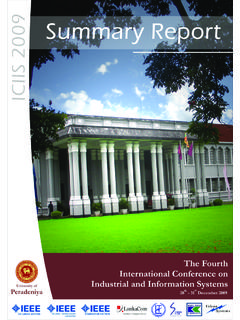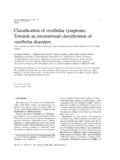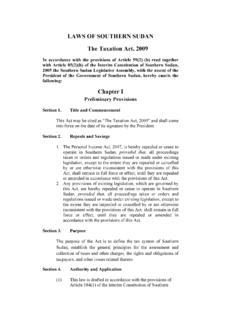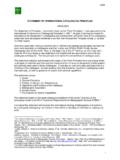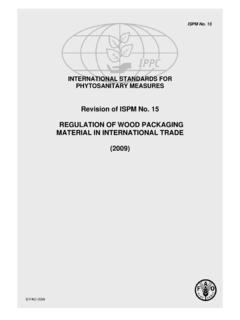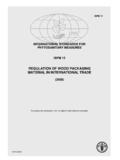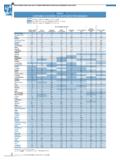Transcription of PISA 2009 Results: Executive Summary - OECD.org
1 PISA 2009 Results: Executive Summary 1 12/1/10 5:53 PM. This work is published on the responsibility of the Secretary-General of the OECD. The opinions expressed and arguments employed herein do not necessarily reflect the official views of the Organisation or of the governments of its member countries. Please cite this publication as: OECD (2010), PISA 2009 Results: Executive Summary The statistical data for Israel are supplied by and under the responsibility of the relevant Israeli authorities. The use of such data by the OECD is without prejudice to the status of the Golan Heights, East Jerusalem and Israeli settlements in the West Bank under the terms of international law.
2 Photo credits: Getty Images Ariel Skelley Getty Images Geostock Getty Images Jack Hollingsworth Stocklib Image Bank Yuri Arcurs Corrigenda to OECD publications may be found on line at: PISATM, OECD/PISATM and the PISA logo are trademaks of the Organisation for Economic Co-operation and Development (OECD). All use of OECD trademarks is prohibited without written permission from the OECD. OECD 2010. You can copy, download or print OECD content for your own use, and you can include excerpts from OECD publications, databases and multimedia products in your own documents, presentations, blogs, websites and teaching materials, provided that suiTabelle acknowledgment of OECD as source and copyright owner is given.
3 All requests for public or commercial use and translation rights should be submitted to Requests for permission to photocopy portions of this material for public or commercial use shall be addressed directly to the Copyright Clearance Center (CCC). at or the Centre fran ais d'exploitation du droit de copie (CFC) at 2 12/1/10 5:53 PM. Introduction to PISA. THE OECD PROGRAMME FOR. INTERNATIONAL STUDENT. ASSESSMENT (PISA). PISA focuses on young people's ability to use their knowledge and skills to meet real-life challenges.
4 This orientation reflects a change in the goals and objectives of curricula themselves, which are increasingly concerned with what students can do with what they learn at school and not merely with whether they have mastered specific curricular content. PISA's unique features include its: Policy orientation, which highlights differences in performance patterns and identifies features common to high- performing students, schools and education systems by linking data on learning outcomes with data on student characteristics and other key factors that shape learning in and outside of school.
5 Innovative concept of literacy , which refers both to students' capacity to apply knowledge and skills in key subject areas and to their ability to analyse, reason and communicate effectively as they pose, interpret and solve problems in a variety of situations. Relevance to lifelong learning, which goes beyond assessing students' competencies in school subjects by asking them to report on their motivation to learn, their beliefs about themselves and their learning strategies. Regularity, which enables countries to monitor their progress in meeting key learning objectives.
6 Breadth of geographical coverage and collaborative nature, which, in PISA 2009 , encompasses the 34 OECD. member countries and 41 partner countries and economies. To learn more about PISA and to download our publications and data, please visit our website: To learn more about the OECD, please visit PISA 2009 Results: Executive Summary OECD 2010 3. 3 12/1/10 5:53 PM. Executive Summary What Students Know and Can Do: Student Performance in Reading, Mathematics and 6. Overcoming Social Background: Equity in Learning Opportunities and 9.
7 Learning to Learn: Student Engagement, Strategies and 12. What Makes a School Successful? Resources, Policies and 15. Learning Trends: Changes in Student Performance Since 19. PISA 2009 Results: Executive Summary OECD 2010 5. 5 12/1/10 5:53 PM. What Students Know and Can Do: Student Performance in Reading, Mathematics and Science What Students Know and Can Do: Student Performance in Reading, Mathematics and Science PISA's conception of reading literacy encompasses the range of situations in which people read, the different ways written texts are presented, and the variety of ways that readers approach and use texts, from the functional and finite, such as finding a particular piece of practical information, to the deep and far-reaching, such as understanding other ways of doing, thinking and being.
8 Research shows that these kinds of reading literacy skills are more reliable predictors of economic and social well-being than the number of years spent in school or in post-formal education. Korea and Finland are the highest performing OECD countries, with mean scores of 539 and 536 points, respectively. However, the partner economy Shanghai-China outperforms them by a significant margin, with a mean score of 556. Top-performing countries or economies in reading literacy include Hong Kong-China (with a mean score of 533), Singapore (526), Canada (524), New Zealand (521), Japan (520) and Australia (515).
9 The Netherlands (508), Belgium (506), Norway (503), Estonia (501), Switzerland (501), Poland (500), Iceland (500) and Liechtenstein (499) also perform above the OECD mean score of 494, while the United States, Sweden, Germany, Ireland, France, Denmark, the United Kingdom, Hungary, Portugal, and partner economy Chinese Taipei have scores close to the OECD mean. The lowest performing OECD country, Mexico, has an average score of 425. This means that the gap between the highest and lowest performing OECD countries is 114 points the equivalent of more than two school years.
10 And the gap between the highest and lowest performing partner country or economy is even larger, with 242 score points or more than six years of formal schooling separating the mean performance of Shanghai-China and Kyrgyzstan (314). Differences between countries represent, however, only a fraction of overall variation in student performance. Addressing the educational needs of such diverse populations and narrowing the gaps in student performance that have been observed remains a formidable challenge for all countries.










